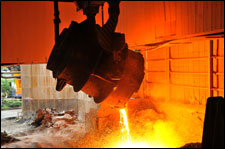 The usage and awareness of steel slag as a useful material for road making is very limited in India today. But with appropriate support from the government of India and state authorities, steel slag can prove to be a cheap and sturdy road construction material, writes Dr. Vijay Joshi, Consultant and Director, DRSlag Consulting Services, India.
The usage and awareness of steel slag as a useful material for road making is very limited in India today. But with appropriate support from the government of India and state authorities, steel slag can prove to be a cheap and sturdy road construction material, writes Dr. Vijay Joshi, Consultant and Director, DRSlag Consulting Services, India.
An extensive and robust road network is one of the major requirements for sustained economic growth. While India has a road network which is among the largest in the world, the country needs to continue to invest in building and augmenting it. Steel Slag is a co-product of the steel making process. Steel slag is being used extensively for various applications in many countries across the world including in USA, Australia, China, and others. Slag has been effectively utilised as an aggregate for road construction. Using slag instead of natural materials is a sustainable alternative with high durability in several applications.
Required policy actions from government towards promoting use of steel slag in this sector: An extensive and robust road network is one of the major requirements for sustained economic growth. While India has a road network which is among the largest in the world, the country needs to continue to invest in building and augmenting it. This is essential in order to support the traffic on roads, which is growing at a rate of 10 per cent per annum.
The government has taken up ambitious programmes such as the National Highway Development Programme (NHDP) and the Pradhan Mantri Gram Sadak Yojana (PMGSY) with the objective of developing the country’s highway and rural road networks, respectively. However, high cost of road construction is a major challenge to government efforts. The annual expenditure of the government on roads is about $3.704 billion1 (Rs.18,000 crore). Road construction costs in India are higher by about 30 per cent in comparison to costs in the United States, due to poor logistics infrastructure. Not only does this result in lower competitiveness, but also hampers economic growth.
A report by the business consulting firm McKinsey has indicated that poor maintenance of roads costs the country about Rs.35,000 crore annually. The report also says that bad roads increase vehicle operating costs, aggregating approximately Rs.20,000 crore annually. Poor roads have been seen to reduce the life of vehicles, increase travel or freight time, push up consumption of fuel and raise maintenance costs of automobiles. The unsuitability of building materials, weak planning, scheduling and monitoring of maintenance operations are all attributed to this.
Why steel slag
Using slag instead of natural materials is a sustainable alternative with high durability in several applications. Slag is exceptionally well suited for road construction, both as asphalt and other construction materials, possesses a number of positive characteristics such as durability and high skid resistance.
 Using slag is a solution that addresses the economic, technical as well as environmental impact of road construction. The usage of slag results in far more cost savings than using natural materials. Running a basic cost-benefit analysis, quarrying and producing natural materials and manufactured aggregates is eliminated to a large degree by using steel slag available at very competitive prices. Using an industrial co-product in place of traditional material conserves reserves of naturally occurring material2. There are potential environmental impacts associated with aggregate extraction including the conversion of land use, changes to the landscape, loss of habitat, noise, dust, blasting effects, erosion, and sedimentation. In addition, extracting aggregate from some areas may alter the dynamic equilibrium of the area, resulting in cascading environmental impact. In addition to that there is also a question of the quality of natural aggregates. With these factors considered, slag is an economically, technically and environmentally sound choice to replace natural materials.
Using slag is a solution that addresses the economic, technical as well as environmental impact of road construction. The usage of slag results in far more cost savings than using natural materials. Running a basic cost-benefit analysis, quarrying and producing natural materials and manufactured aggregates is eliminated to a large degree by using steel slag available at very competitive prices. Using an industrial co-product in place of traditional material conserves reserves of naturally occurring material2. There are potential environmental impacts associated with aggregate extraction including the conversion of land use, changes to the landscape, loss of habitat, noise, dust, blasting effects, erosion, and sedimentation. In addition, extracting aggregate from some areas may alter the dynamic equilibrium of the area, resulting in cascading environmental impact. In addition to that there is also a question of the quality of natural aggregates. With these factors considered, slag is an economically, technically and environmentally sound choice to replace natural materials.
Steps needed to promote use of steel slag in road making: The way forward: There is little government policy to regulate and monitor the use of steel slag for road construction. This has perhaps resulted in misconceptions on the use and benefit of steel slag. The free lime content in steel slag can lead to expansion; however, proper aging process takes care of this phenomenon. The full scale trials (actually building roads) in consultation with a testing agency or local authority could be an ideal start. And of course, change of specifications by Indian Road Congress to allow usage of steel slag as road aggregates, based on these trials, is the final step. The government needs to issue proper guidelines on the testing and processing of slag for its suitability of use. Before any application can be accepted and established, it requires statutory approvals from various government agencies and bodies such as the Indian Roads Congress, Central Road Research Institute etc.
The usage and awareness of steel slag as a useful material for road making is very limited in India today. However, many countries particularly developed economies including the European Union have used steel slag in a variety of applications including road, rail ballast, pavement, sandwich construction, water purification, landfill etc.
With appropriate support from the Government of India and state authorities, steel slag can prove to be a cheap and sturdy road construction material. Its application will also help to tackle the problem of storage and accumulation of high volumes of slag. With the country’s steelmaking capacity increasing at an appreciable rate, the amount of steel slag generated would also increase substantially. As infrastructure needs in the country grow, the use of this material will help to address raw material challenges and environmental concerns.
Notes:
- https://www.pppinindia.com/sector-highways.php
- Lüttig, 1994











